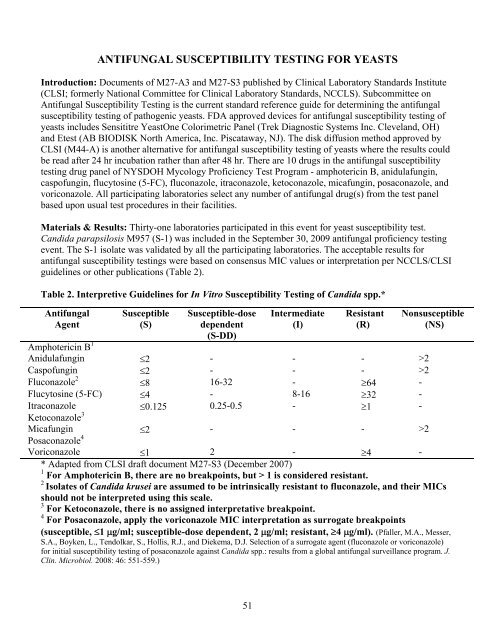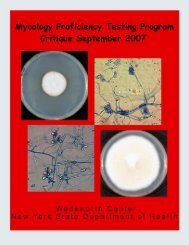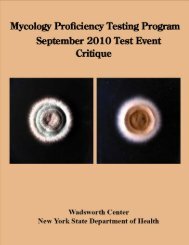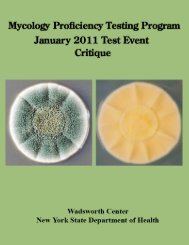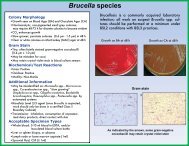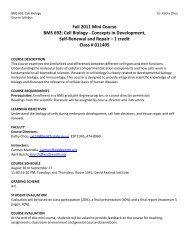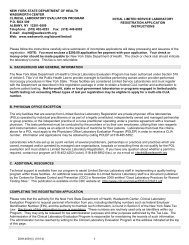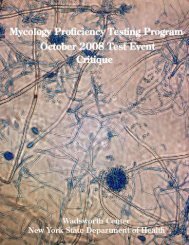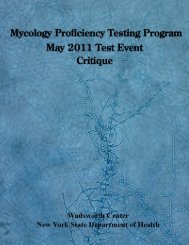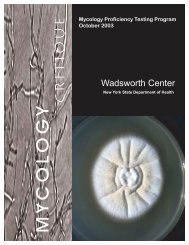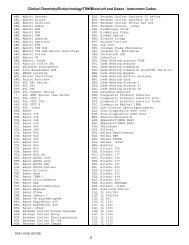September 2009 - Wadsworth Center
September 2009 - Wadsworth Center
September 2009 - Wadsworth Center
- No tags were found...
Create successful ePaper yourself
Turn your PDF publications into a flip-book with our unique Google optimized e-Paper software.
ANTIFUNGAL SUSCEPTIBILITY TESTING FOR YEASTSIntroduction: Documents of M27-A3 and M27-S3 published by Clinical Laboratory Standards Institute(CLSI; formerly National Committee for Clinical Laboratory Standards, NCCLS). Subcommittee onAntifungal Susceptibility Testing is the current standard reference guide for determining the antifungalsusceptibility testing of pathogenic yeasts. FDA approved devices for antifungal susceptibility testing ofyeasts includes Sensititre YeastOne Colorimetric Panel (Trek Diagnostic Systems Inc. Cleveland, OH)and Etest (AB BIODISK North America, Inc. Piscataway, NJ). The disk diffusion method approved byCLSI (M44-A) is another alternative for antifungal susceptibility testing of yeasts where the results couldbe read after 24 hr incubation rather than after 48 hr. There are 10 drugs in the antifungal susceptibilitytesting drug panel of NYSDOH Mycology Proficiency Test Program - amphotericin B, anidulafungin,caspofungin, flucytosine (5-FC), fluconazole, itraconazole, ketoconazole, micafungin, posaconazole, andvoriconazole. All participating laboratories select any number of antifungal drug(s) from the test panelbased upon usual test procedures in their facilities.Materials & Results: Thirty-one laboratories participated in this event for yeast susceptibility test.Candida parapsilosis M957 (S-1) was included in the <strong>September</strong> 30, <strong>2009</strong> antifungal proficiency testingevent. The S-1 isolate was validated by all the participating laboratories. The acceptable results forantifungal susceptibility testings were based on consensus MIC values or interpretation per NCCLS/CLSIguidelines or other publications (Table 2).Table 2. Interpretive Guidelines for In Vitro Susceptibility Testing of Candida spp.*AntifungalAgentSusceptible(S)Susceptible-dosedependent(S-DD)Intermediate(I)Resistant(R)Amphotericin B 1Anidulafungin ≤2 - - - >2Caspofungin ≤2 - - - >2Fluconazole 2 ≤8 16-32 - ≥64 -Flucytosine (5-FC) ≤4 - 8-16 ≥32 -Itraconazole ≤0.125 0.25-0.5 - ≥1 -Ketoconazole 3Micafungin ≤2 - - - >2Posaconazole 4Nonsusceptible(NS)Voriconazole ≤1 2 - ≥4 -* Adapted from CLSI draft document M27-S3 (December 2007)1 For Amphotericin B, there are no breakpoints, but > 1 is considered resistant.2Isolates of Candida krusei are assumed to be intrinsically resistant to fluconazole, and their MICsshould not be interpreted using this scale.3 For Ketoconazole, there is no assigned interpretative breakpoint.4 For Posaconazole, apply the voriconazole MIC interpretation as surrogate breakpoints(susceptible, ≤1 μg/ml; susceptible-dose dependent, 2 μg/ml; resistant, ≥4 μg/ml). (Pfaller, M.A., Messer,S.A., Boyken, L., Tendolkar, S., Hollis, R.J., and Diekema, D.J. Selection of a surrogate agent (fluconazole or voriconazole)for initial susceptibility testing of posaconazole against Candida spp.: results from a global antifungal surveillance program. J.Clin. Microbiol. 2008: 46: 551-559.)51


